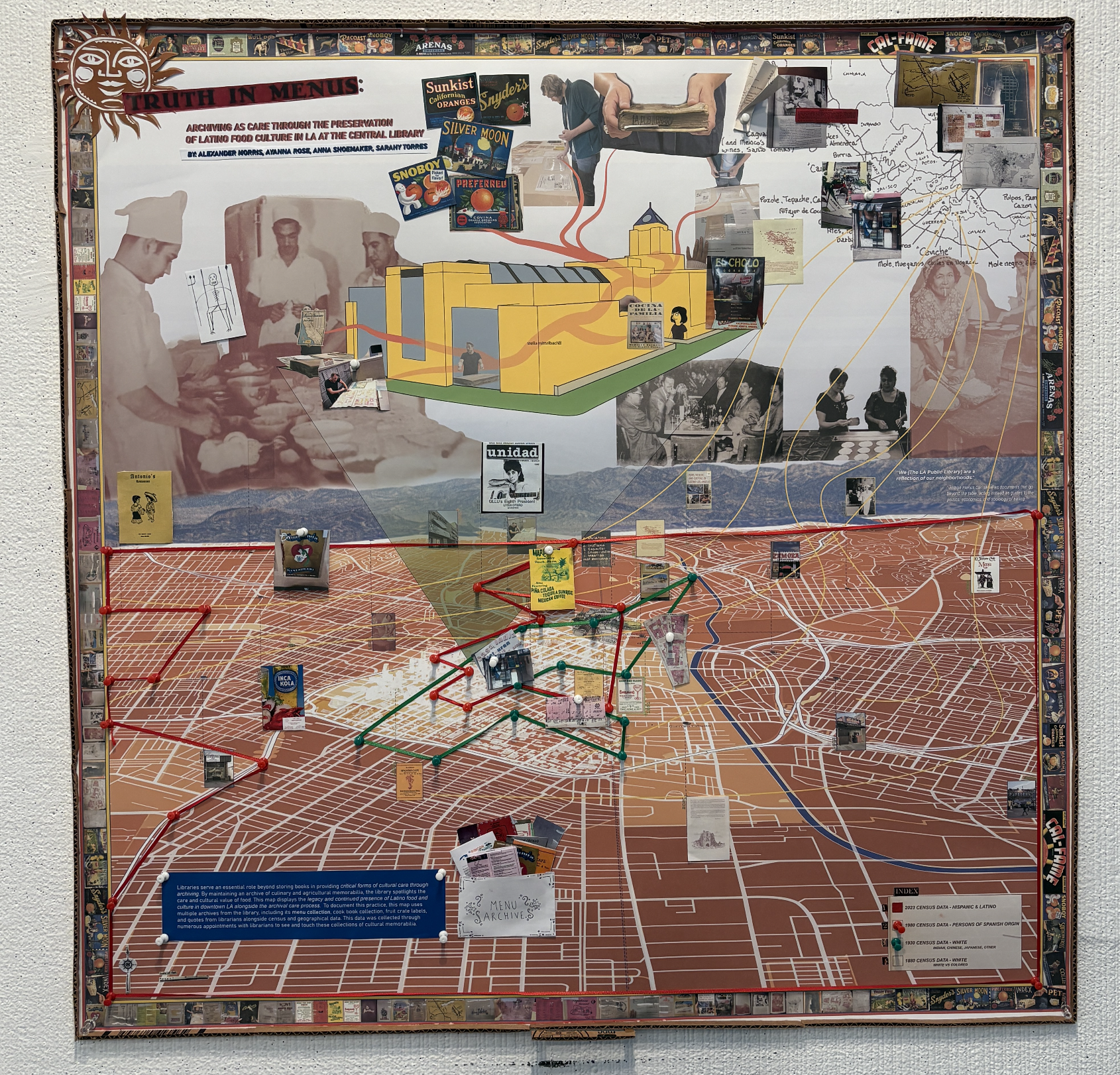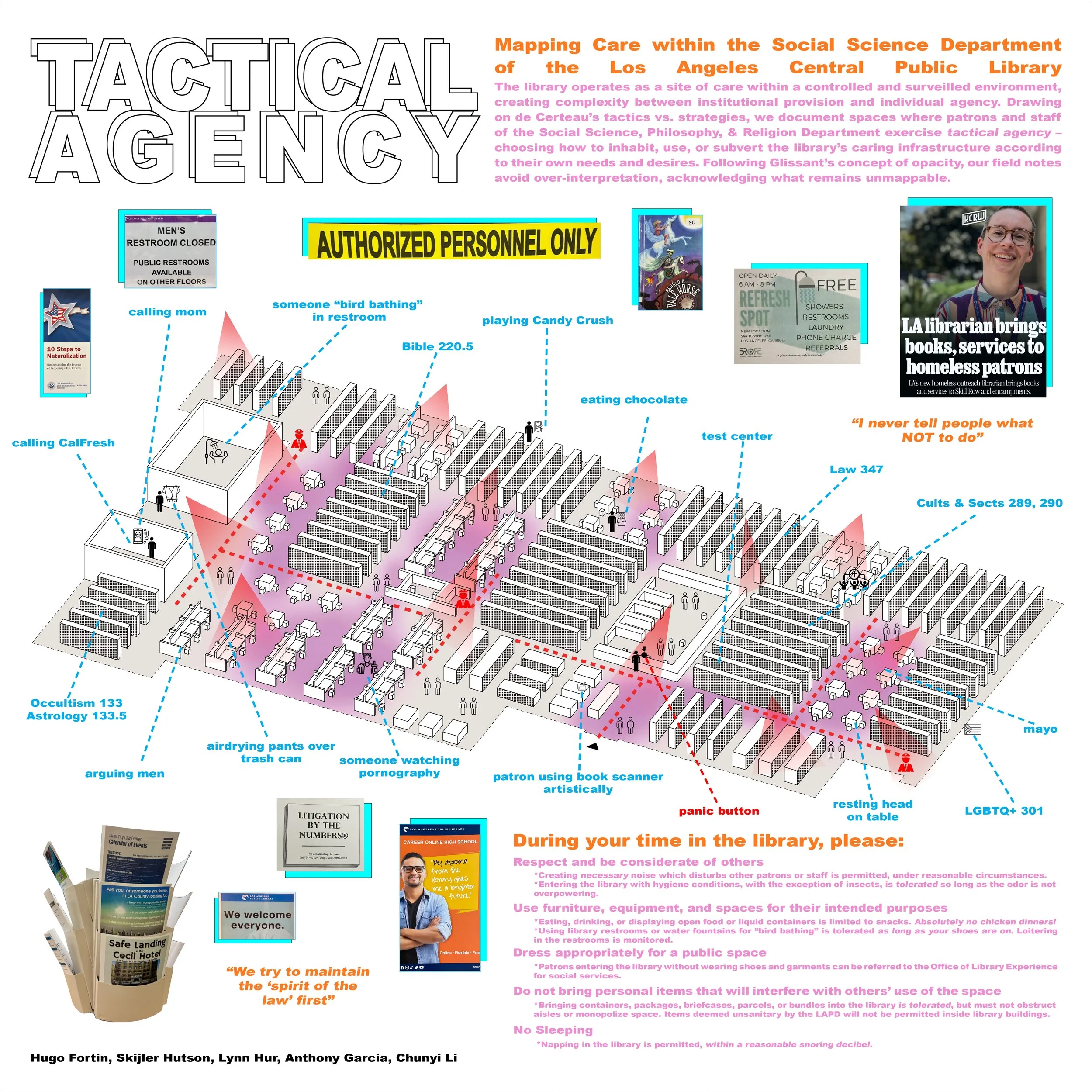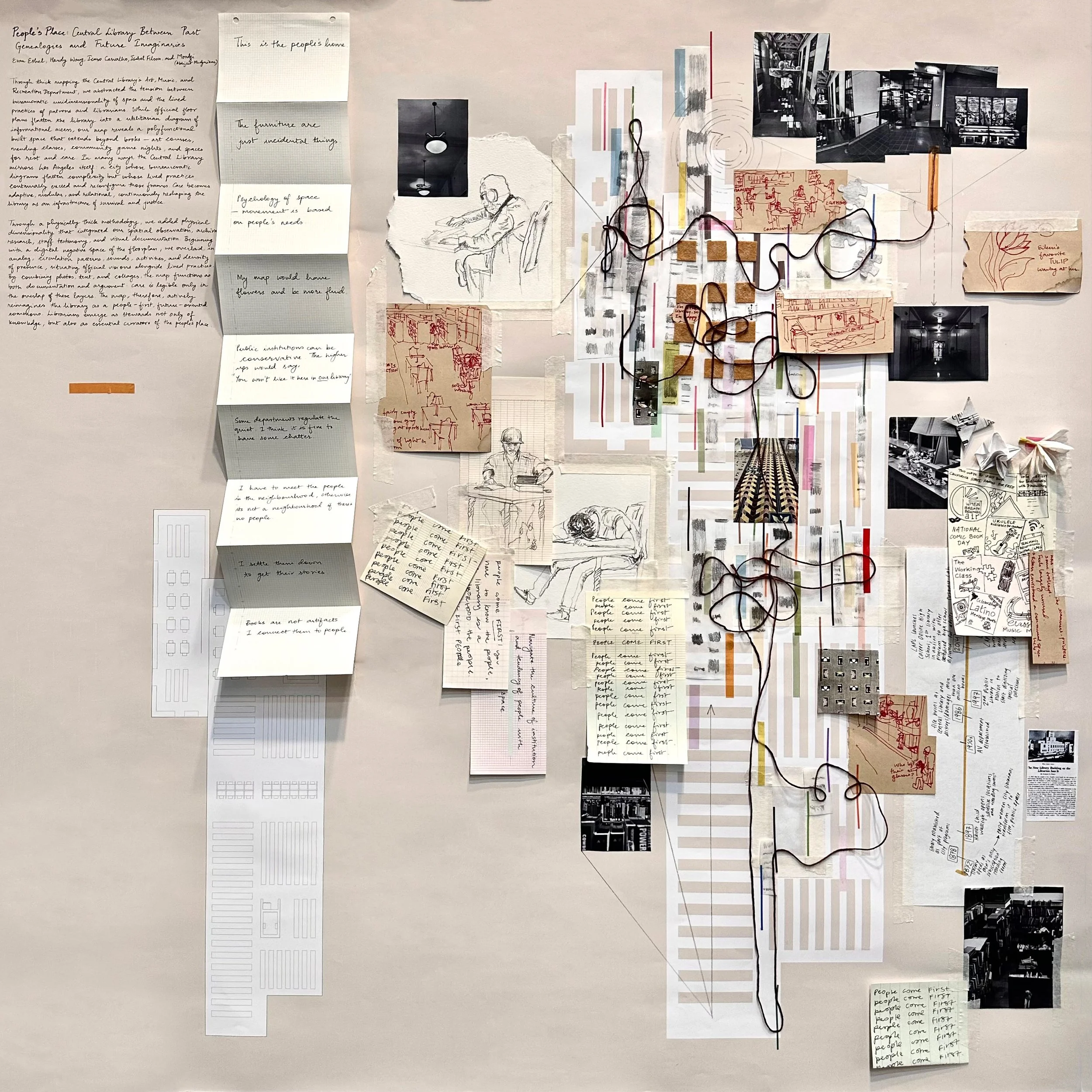Summer Institute 2025
Critical reflections on care: Mapping spaces, stories, and services at the Los Angeles Public Library
Instructors: Claire Nelischer, Doğa Tekin
Students: UHI 2025-26 Cohort
Community Partner: Los Angeles Public Library Central Branch staff and librarians
The 2025-2026 UHI Graduate Certificate program launched with a week-long Summer Institute, introducing the theme of "care as critical spatial practice". The Summer Institute equips incoming students with the foundational theories, fieldwork practices, and representational tools to create a "thick map" - a core practice in the urban humanities.
Given the Los Angeles Public Library's (LAPL) long history and presence in Los Angeles and its role in providing essential public services that extend beyond the space of the library itself, students’ thick mapping projects were focused in and around the LAPL Central Branch. The projects were driven by the questions:
How are practices of care spatialized within the LAPL Central Branch, and how do these practices reflect and extend into the city beyond its doors?
What stories about care practices in Los Angeles are told in and through the library's collections, infrastructures, and services to its publics?
Guided by the teaching team and with presentations and research support from LAPL librarians and staff, students worked in teams to address the above questions using a variety of methodological approaches, including archival research, spatial analysis, and multi-sensory. Students engaged with LAPL staff members in both their capacities as research guides to help navigate library resources and collections, as well as individuals with valuable lived experience as library workers and stakeholders.

Truth in Menus
UHI Summer Institute 2025
Students: Anna Shoemaker, Sarahy Torres, Alexander Morris, Ayanna Rose
The Los Angeles Public Library shows care as a critical spatial practice through archiving as a form of cultural care. This is demonstrated particularly in the collections of cultural memorabilia (menus, fruit crate labels, photographs, etc.) that establish the local permanence of the Latino community as both present before and essential throughout the establishment of America. Care is a constitutive process of celebration and memorialization of communal practices. Remembrance and documentation are forms of resistance, inherently giving these culinary and agricultural documents cultural, spatial, and financial value. Care is upheld by the library for Angeleno Latino subcultures and communities through the preservation of food culture and agricultural history, collecting and archiving the lived multi-temporal knowledge of local communities. These archival collections resist both Los Angeles' endemic erasure of its own past as well as the current climate of redaction of diverse history from public institutions. Our map spatializes the legacy and continued presence of Latino food and culture in downtown LA alongside the archival care process to celebrate and locate the journey of food-making knowledge through these communities into the landscape of the city. To document this practice, this map uses multiple archives from the library, including its Menu collection, Fruit Crate Label, and quotes from librarians alongside census and geographical data. This data was collected through numerous appointments with librarians to see and touch these collections of cultural memorabilia.

Tactical Agency: Mapping Care within the Social Science Department of the Los Angeles Central Public Library
UHI Summer Institute 2025
Students: Hugo Fortin, Skijler Hutson, Lynn Hur, Anthony Garcia, Chunyi Li
The library operates as a site of care within a controlled and surveilled environment, creating complexity between institutional provision and individual agency. Drawing on de Certeau’s tactics vs. strategies, we document spaces where patrons and staff of the Social Science, Philosophy, & Religion Department exercise tactical agency – choosing how to inhabit, use, or subvert the library’s caring infrastructure according to their own needs and desires. Following Glissant’s concept of opacity, our field notes avoid over-interpretation, acknowledging what remains unmappable.

People’s Place: Central Library Between Past Genealogies and Future Imaginaries
UHI Summer Institute 2025
Students: Evan Eshel, Hardy Wang, Ícaro Carvalho, Isabel Filson, and Moodzi (Abhijeet Mudgerikar)
Through thick mapping the Central Library’s Art, Music, and Recreation Department, we abstracted the tension between bureaucratic unidimensionality of space and the lived practices of patrons and librarians. While official floorplans flatten the library into a utilitarian diagram of informational access, our map reveals a polyfunctional built space that extends beyond books—art courses, mending classes, community game nights, and spaces for rest and care. In many ways, the Central Library mirrors Los Angeles itself: a city whose bureaucratic diagrams flatten complexity but whose lived practices continually exceed and reconfigure those frames. Care becomes adaptive, modular, and relational, continuously reshaping the library as an infrastructure of survival and justice. Through a physically thick methodology, we added physical dimensionality that integrated our spatial observation, archival research, staff testimony, and visual documentation. Beginning with a digital negative space of the floorplan, we overlaid, in analog, circulation patterns, sounds, activities, and density of presence, situating official visions alongside lived practices. By combining photos, text, and collages, the map functions as both documentation and argument: care is legible only in the overlap of these layers. The map, therefore, actively reimagines the library as a people-first, future-oriented commons. Librarians emerge as stewards not only of knowledge, but also as essential curators of the people’s place.

Body of Care
UHI Summer Institute 2025
Students: Serafin Olguin, Shiyue Shen, Anatoli Ulyanov, Heidi Yang, & Kathy Zhang
This thick map frames the Los Angeles Central Library as a civic body whose organs sustain forms of care beyond books. In the absence of adequate public infrastructures, the library has absorbed roles as cooling center, refuge, workplace, and cultural commons. Our archive assembles stories from librarians, patrons, social workers, janitors, and security, layered with data on budgets, flows, and surveillance. Through interviews, fieldnotes, sketching, photo-sensing, and archival digging, we trace patrons as circulating blood through this body—revealing how the library both carries the burden of systemic neglect and becomes a laboratory of public imagination amid shrinking civic space.
